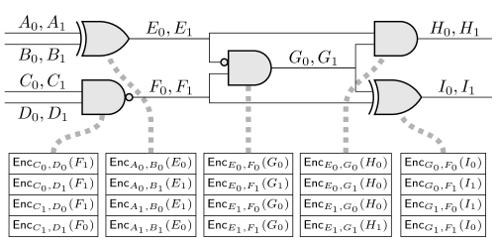This library is a Haskell DSL for secure two-party computation with garbled circuits. You can use it to create secure protocols in the honest but curious model. That is - parties in the protocols won't find out each other's inputs, as long as they follow the protocol.
Two parties can make a garbled circuit to find the output of a function without learning each other's input. The function can be any that can be expressed as a boolean circuit. Each gate of the circuit encrypts its output by using its input as keys. Since a party can only know a gate's output if it has the right input, only the correct output is recoverable.
The two parties are the Garbler and the Evaluator, who agree on a circuit to
compute. The Garbler creates random values for each wire in the circuit (we
call them wirelabels) and encrypts the output of each gate with its input
wirelabels. The Garbler begins the protocol by sending its input wirelabels
and the garbled circuit to the Evaluator. Next, the Evaluator needs to find
out what its input wirelabels are, but do so without revealing what its input
is. We use oblivious transfer
for that. The Evaluator evaluates the circuit and sends the output wirelabels back to the Garbler, who ungarbles them and reveals the output to the Evaluator.
garbled-circuits supports the latest circuit-size optimizations, including
half-gates, and uses AES128 with AESNI
support for hashing. It uses oblivious transfer
extension
to minimize the number of expensive oblivious transfers (which are based on
asymmetric crypto).
In this section, we'll show how to construct a simple bitwise 'and' protocol.
We'll be constructing two source files: Garbler.hs and Evaluator.hs to
be the respecive parties in the protocol. You can find these files in the
examples/bit-and directory.
First we define a circuit using the Crypto.GarbledCircuits.Language module.
We use the smart constructors in the way you'd expect any normal monadic code
to work. Note, since this is a two-party protocol, we need to specify where
input comes from. That's what the Garbler and Evaluator data constructors
are for.
The following code is common to both Garbler.hs and Evaluator.hs
module Main where
import Prelude hiding (and)
import System.Environment
import Crypto.GarbledCircuits
import Crypto.GarbledCircuits.Language
bitAnd :: Program Circuit
bitAnd = buildCircuit $ do
x <- input Garbler
y <- input Evaluator
z <- and x y
return [z]Next, we define a simple main function for Garbler.hs. The *Proto
functions last argument is a pair that provide sending and recieving
ByteStrings. simpleConn makes such a pair out of a Handle, which is
provided by listenAt and connectTo. See Crypto.GarbledCircuits.Network for
more details.
main :: IO ()
main = do
args <- getArgs
let port = read (args !! 0)
inp = read (args !! 1) :: Bool
proto = garblerProto bitAnd [inp] . simpleConn
result <- listenAt port proto
print resultWe do the same for Evaluator.hs.
main :: IO ()
main = do
args <- getArgs
let server = args !! 0
port = read (args !! 1)
inp = read (args !! 2) :: Bool
proto = evaluatorProto bitAnd [inp] . simpleConn
result <- connectTo server port proto
print resultFinally, once we compile, we can preform an oblivious bitwise and! The final line is the output.
% ./bit-and-garbler.a 12345 True
[garblerProto] circuit garbled
[garblerProto] sending circuit
[garblerProto] sending my input wires
[garblerProto] sending key
[garblerProto] performing OT
[garblerProto] recieving output
[garblerProto] sending ungarbled output
[False]% ./bit-and-evaluator.a localhost 12345 False
[evaluatorProto] recieving circuit
[evaluatorProto] recieving garbler input wires
[evaluatorProto] recieving key
[evaluatorProto] performing OT
[evaluatorProto] evaluating garbled circuit
<0>: in0 Garbler wl1 2c7ec10d3db507bd48357360650fa319
<1>: in1 Evaluator
<2>: HALFGATE <0> <1> out0
wl0 1a164c333d7ab142e8388cd940f55144
wl1 854e5157edd04dcbe7779dfba2a02151
[eval] <2>[0,1] HalfGate result = wl0 23f6a3ac3c66315fd9915672ac1b5022
[evaluatorProto] output =
<2> wl0 23f6a3ac3c66315fd9915672ac1b5022
[evaluatorProto] sending output wires
[evaluatorProto] recieving ungarbled output
[False]garbled-circuits consists of three languages: Circuit, TruthTable, and
GarbledGate.
Circuit is for building boolean circuits. It's the user-facing language. It's
available in Garbled.Circuits.Language. It has smart constructors like or
and not as in the example above. You can use the smart constructor to get a
reference to the output, which you use as an argument to other constructors.
The CircuitBuilder monad compiles down to a boolean circuit.
TruthTable is an intermediate langauge between Circuit and GarbledGate.
It's role is to compress gates that are possibly unary or nullary (like not
and const) into the binary gates above them. The user shouldn't have to worry
about TruthTable.
GarbledGate is a garbled circuit. Each binary gate in TruthTable gets
assigned a true and a false wire label. This wirelabel is the input
to the gates above in the circuit. Each gate encrypts its output with the
correct input as keys. The Evaluator is only able to decrypt the output
corresponding to the input wires it holds, ensuring authentic output of the
whole garbled circuit.
- circuit language - done
- intermediate TruthTable representation - done
- garbling
- AES hashing - done
- crypto rng - done
- garbling optimizations (free xor, half gates) - done
- network boilerplate - done
- oblivious transfer - in progress
- find more appropriate OT - in progress
- OT extension - done
- haddock documentation - in progress
- profiling
garbled-circuits is licenced under Apache 2.0
EXPERIMENTAL: USE AT YOUR OWN RISK
Copyright 2015 Brent Carmer
